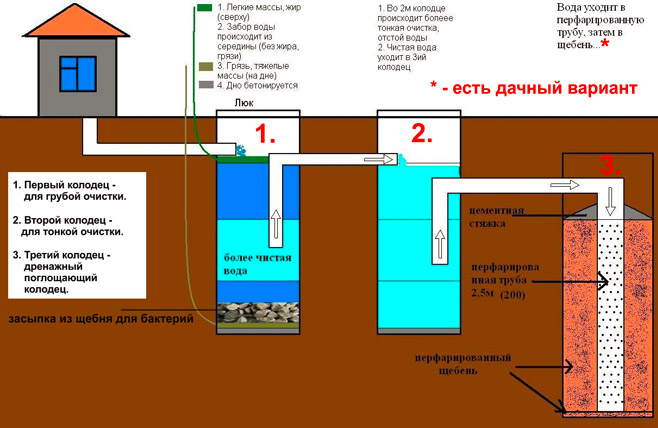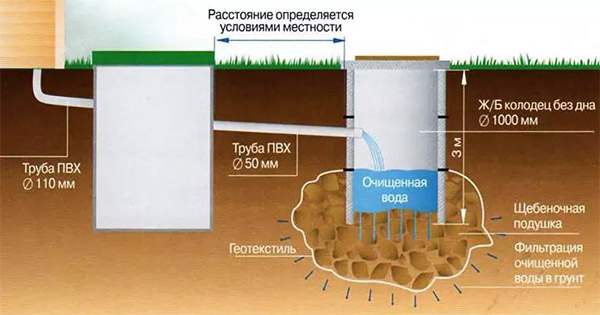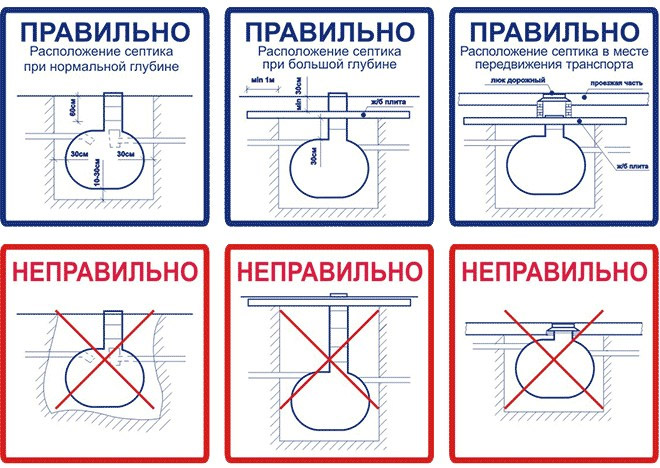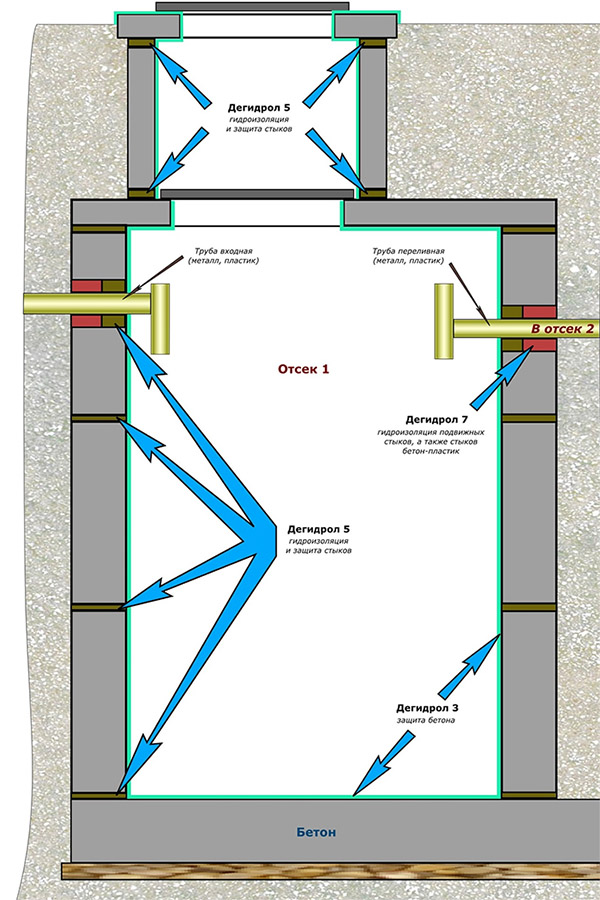The actual problem of suburban life is the lack of a central sewerage system. Creating your own autonomous system is technically difficult and expensive. The arrangement of a cesspool is no longer practiced. The most common, modern and effective solution for the construction of suburban treatment facilities is considered. It can be assembled from concrete rings or be monolithic.
- Simple and unpretentious to operate.
- All work can be done on your own.
- An inexpensive option available to everyone.
Disadvantages:
- Smell. The poorly sealed design does not completely prevent odors.
- Risk of dirty water getting into the ground in case of installation errors.
- The need for cleaning. You should regularly resort to the services of a sewer to clean up solid waste.
Despite the opinion that a concrete septic tank is considered the most affordable sewerage option in the country and in a private house, professionals are not recommended to install it in a house intended for living all year round.
The process includes several stages:
1. Calculation of the volume and the choice of the scheme.
2. Determination of the construction site.
3. Digging a well.
4. Directly mounting rings and supplying communications.
5. Sealing of seams and joints.
6. Installation of floors.
7. Backfilling of chambers.
Operating principle
A description of the work scheme will help you understand how to properly make a septic tank from concrete rings with your own hands and save on calling specialists. The standard version is a section of two or three wells.
1. The first, which has a concrete bottom, gets sewage drains. There, solid waste undergoes primary treatment by deep decomposition under the action of anaerobic bacteria, is converted into a thick sediment and continues along a drain pipe located at an angle to the septic tank. In this case, 1 m of depth corresponds to two centimeters of the slope. Since cleaning takes place due to the fermentation of sewage, this tank must be sealed.
2. The second stage of cleaning is filtration by passing through expanded clay, gravel and other materials. The second well is identical in design to the first, but it may be smaller in size and must be filled with oxygen, which helps bacteria to decompose sewage into its constituent elements.
3. From the third reservoir, the scheme assumes drainage of the completely purified liquid into the ground in a natural way or using a forced pump. This well should be located closer to the road for better accessibility to sewage services.

Sizing calculation
As part of this structure, there are both one and two chambers: for settling and purifying wastewater. The layout of a septic tank made of concrete rings for three wells includes both chambers and filtration. The design can be different and depends on the number of residents and their residence time per year. If there are two people in the house who actively use the dishwasher and washing machine, bathroom and shower, then one tank will not be enough, since it will not cope with large discharges into the sewer, therefore, a second is needed.
If the family is small and uses a minimum of household appliances, then septic tanks from two wells are suitable. Moreover, their size is determined by the amount of wastewater. The septic tank should be three times the daily volume of fluid entering it. According to technology, water must be in it all the time. According to user reviews, such a septic tank is in no way inferior to a three-well one.
Calculation example:
1. The country house is home to 5 family members. The daily water consumption for 1 person is 200 liters.
2. Determine the daily consumption for the whole family: 5 * 200 = 1000 liters.
3. Multiply the total daily consumption of the family by 3 (since, according to building codes, a concrete septic tank should hold a three-day volume of wastewater), we get 3000 liters. That is, the chamber must be at least 3 cubes.
4. The volume of the standard ring is 0.62 m3. We determine their number: the found volume of the septic tank is divided by the volume of the ring 3 / 0.62 = 4.83. When rounded up, we get 5 pieces. That is, for the construction of one chamber, 5 pieces are needed.

Nuances of work
If the sewage system is being built independently, then in order to properly organize the work, several factors must be taken into account.
- Soil heaving.
One of the problems is the increase in the soil under the influence of external factors (soil swelling). This must be taken into account and before installation, create a soil belt (sand cushion) with a thickness of at least 30 cm. Expanded clay or similar can serve as the material.
Also, to prevent the consequences of heaving, according to the standard installation scheme, to prevent shear, they are interconnected by means of metal plates fixed with brackets or bolts.

- The need for technology.
It is better to prepare in advance and rent a crane and a truck. It is better to dig all three wells in advance and think over the approach to the work site.
- Accuracy.
Chipping and cracking of the concrete should be avoided during installation.
- Ecology of the site.
Great attention should be paid to sealing so that waste water does not leak through the first two treatment tanks. Pillows and water glass will help to properly protect the soil from leaks.

Installation features
Stages of assembling a septic tank from concrete rings with your own hands.
1. Choice of location.
After the selection of the scheme, they are determined with the area where the sewage system will be located. It is necessary to place containers at a distance from one meter to groundwater. The GWL indicator is a problem characteristic of almost all central regions of Russia. A septic tank with a high level of groundwater is much more difficult to install and use, therefore, when planning a sewage system, the condition of the soil of the area must be taken into account.
A high ground level is considered to be a parameter less than a meter. The maximum indicator will be the most objective, therefore, measurements are best taken in spring when snow melts or in autumn during a rainy period. If there is a well on the ground that is powered by groundwater, then the GWL is determined by measuring the distance between the liquid level in it and the earth's surface.
If there is a problem with the groundwater level, then more attention should be paid to sealing. Due to the fact that structures consisting of prefabricated elements (brick or concrete rings) do not provide proper tightness, you should resort to installing an industrial septic tank.
2. Digging a pit.
The diameter of the pit for a concrete septic tank should be wider than the concrete rings, so that after installation there is room for laying a waterproofing layer. The shape of the pit can be square (for a concrete slab) or oval (for a cement stretch).
3. Sealing the pit.
0.3 m of sand is poured inside, and, after pre-treatment with cement mortar, slabs or stretching are laid.

4. Installation of rings.
The rings are dropped one at a time. The pipe passages are insulated to prevent cracks after concrete shrinkage, the joints between the rings are sealed with cement and treated with silicone grease for sealing.
5. Treatment wells of a septic tank.
Wells are being drilled with a depth of 1 m, pipes are placed in them, inside of which rubble is poured to protect the walls from organic deposits.
6. Sewerage pipes.
It is necessary to ensure the unimpeded movement of water between the tanks. To do this, the pipe is brought into the well, the first in a row, at a slight angle, and in each subsequent one it is placed 20 cm lower.
7. Waterproofing.
The outer walls of the sewer are treated with clay.

8. Cover.
Finally, a plastic hatch is placed on a septic tank made of concrete rings.
Tips for installing a septic tank for giving yourself:
- To prevent the sewer from freezing, the rings should be insulated.
- A ventilation hole is desirable on each container of a concrete septic tank.
- The strength of the structure is increased if the rings are connected with metal staples.
- A hatch cover helps to monitor the condition of the septic tank.
- Rental of special equipment will facilitate the construction of a septic tank.
Installation prices by specialists
The cost of installing a turnkey septic tank depends on the size of the sewer. On average, the price of one ring is 2000. The cost of work is 2500 rubles.
The cost of drainage is 7,500 rubles, installation with the necessary pipes and insulation - 14,000, carrying pipes into the house - 2,500 with a columnar foundation and 6,000 - with a strip foundation.
Also, once every few years (depending on the intensity of use), the services of companies for cleaning cesspools will be required. Prices start from 1000 rubles per 1 m3.



